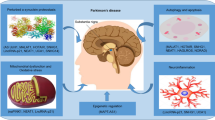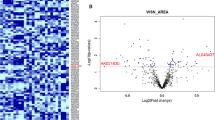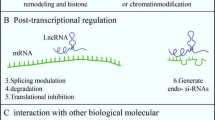Abstract
Parkinson’s disease (PD) is a slowly progressing neurodegenerative disorder that affects approximately seven million patients worldwide. Despite intensive research, the molecular mechanisms initiating and promoting PD are still unknown. However, it is assumed that environmental factors trigger PD. Recent research demonstrated that long noncoding RNAs (lncRNA) interfere in transcriptional and translational processes modulating gene expression reflecting environmental influences. Nevertheless, there is no systematic analysis available that investigates the impact of lncRNAs on PD. In the current study, we performed a comprehensive analysis on expression levels of 90 well-annotated lncRNAs in 30 brain specimens deriving from 20 PD patients and 10 controls as a preliminary report on the significance of lncRNAs in PD. Expression profiling of lncRNAs revealed that five lncRNAs are significantly differentially expressed in PD. While H19 upstream conserved 1 and 2 is significantly downregulated in PD, lincRNA-p21, Malat1, SNHG1, and TncRNA are significantly upregulated. An analysis on expression levels and PD stages revealed that the identified dysregulated lncRNA are altered already in early disease stage and that they precede the course of PD. In summary, this is the first comprehensive analysis on lncRNAs in PD revealing significantly altered lncRNAs. Additionally, we found that lncRNA dysregulations precede the course of the disease. Thus, the five newly identified lncRNAs may serve as potential new biomarkers appropriate even in early PD. They may be used in monitoring disease progression and they may serve as potential new targets for novel therapeutic approaches.



Similar content being viewed by others
References
de Lau LM, Breteler MM (2006) Epidemiology of Parkinson’s disease. Lancet Neurol 5:525–535. doi:10.1016/S1474-4422(06)70471-9
Noyce AJ et al (2012) Meta-analysis of early nonmotor features and risk factors for Parkinson disease. Ann Neurol 72:893–901. doi:10.1002/ana.23687
Van Maele-Fabry G, Hoet P, Vilain F, Lison D (2012) Occupational exposure to pesticides and Parkinson’s disease: a systematic review and meta-analysis of cohort studies. Environ Int 46:30–43. doi:10.1016/j.envint.2012.05.004
Carninci P et al (2005) The transcriptional landscape of the mammalian genome. Science 309:1559–1563. doi:10.1126/science.1112014
Derrien T et al (2012) The GENCODE v7 catalog of human long noncoding RNAs: analysis of their gene structure, evolution, and expression. Genome Res 22:1775–1789. doi:10.1101/gr.132159.111
Johnson JM, Edwards S, Shoemaker D, Schadt EE (2005) Dark matter in the genome: evidence of widespread transcription detected by microarray tiling experiments. Trends Genet 21:93–102. doi:10.1016/j.tig.2004.12.009
Mattick JS (2009) The genetic signatures of noncoding RNAs. PLoS Gen 5, e1000459. doi:10.1371/journal.pgen.1000459
Bu D et al (2012) NONCODE v3.0: integrative annotation of long noncoding RNAs. Nucleic Acids Res 40:D210–D215. doi:10.1093/nar/gkr1175
Ma L, Bajic VB, Zhang Z (2013) On the classification of long non-coding RNAs. RNA Biol 10
Mattick JS, Amaral PP, Dinger ME, Mercer TR, Mehler MF (2009) RNA regulation of epigenetic processes. BioEssays 31:51–59. doi:10.1002/bies.080099
Carrel L et al (1996) X inactivation analysis and DNA methylation studies of the ubiquitin activating enzyme E1 and PCTAIRE-1 genes in human and mouse. Hum Mol Genet 5:391–401
Clemson CM, McNeil JA, Willard HF, Lawrence JB (1996) XIST RNA paints the inactive X chromosome at interphase: evidence for a novel RNA involved in nuclear/chromosome structure. J Cell Biol 132:259–275
Lee JT, Bartolomei MS (2013) X-inactivation, imprinting, and long noncoding RNAs in health and disease. Cell 152:1308–1323. doi:10.1016/j.cell.2013.02.016
Lee JT, Davidow LS, Warshawsky D (1999) Tsix, a gene antisense to Xist at the X-inactivation centre. Nat Gen 21:400–404. doi:10.1038/7734
Penny GD, Kay GF, Sheardown SA, Rastan S, Brockdorff N (1996) Requirement for Xist in X chromosome inactivation. Nature 379:131–137. doi:10.1038/379131a0
Zhao J et al (2010) Genome-wide identification of polycomb-associated RNAs by RIP-seq. Mol Cell 40:939–953. doi:10.1016/j.molcel.2010.12.011
Zhao J, Sun BK, Erwin JA, Song JJ, Lee JT (2008) Polycomb proteins targeted by a short repeat RNA to the mouse X chromosome. Science 322:750–756. doi:10.1126/science.1163045
Sun S, Del Rosario BC, Szanto A, Ogawa Y, Jeon Y, Lee JT (2013) Jpx RNA activates Xist by evicting CTCF. Cell 153:1537–1551. doi:10.1016/j.cell.2013.05.028
Tian D, Sun S, Lee JT (2010) The long noncoding RNA, Jpx, is a molecular switch for X chromosome inactivation. Cell 143:390–403. doi:10.1016/j.cell.2010.09.049
Nie L et al (2012) Long non-coding RNAs: versatile master regulators of gene expression and crucial players in cancer. Am J Transl Res 4:127–150
Prensner JR, Chinnaiyan AM (2011) The emergence of lncRNAs in cancer biology. Cancer Discovery 1:391–407. doi:10.1158/2159-8290.CD-11-0209
Schonrock N, Gotz J (2012) Decoding the non-coding RNAs in Alzheimer’s disease. Cell Mol Life Sci 69:3543–3559. doi:10.1007/s00018-012-1125-z
McKeith IG et al (2005) Diagnosis and management of dementia with Lewy bodies: third report of the DLB Consortium. Neurology 65:1863–1872. doi:10.1212/01.wnl.0000187889.17253.b1
Pelvig DP, Pakkenberg H, Stark AK, Pakkenberg B (2008) Neocortical glial cell numbers in human brains. Neurobiol Aging 29:1754–1762. doi:10.1016/j.neurobiolaging.2007.04.013
Wagner M et al (2015) Age-Dependent Levels of 5-Methyl-, 5-Hydroxymethyl-, and 5-Formylcytosine in Human and Mouse Brain Tissues. Angew Chem. doi:10.1002/anie.201502722
Kraus TF, Greiner A, Guibourt V, Kretzschmar HA (2014) Long non-coding RNA normalisers in human brain tissue. J Neural Transm. doi:10.1007/s00702-014-1352-6
Kraus TF, Greiner A, Guibourt V, Lisec K, Kretzschmar HA (2015) Identification of stably expressed lncRNAs as valid endogenous controls for profiling of human glioma. J Cancer 6:111–119. doi:10.7150/jca.10867
Amaral PP, Clark MB, Gascoigne DK, Dinger ME, Mattick JS (2011) lncRNAdb: a reference database for long noncoding RNAs. Nucleic Acids Res 39:D146–D151. doi:10.1093/nar/gkq1138
Tang L, Zhang W, Su B, Yu B (2013) Long noncoding RNA HOTAIR is associated with motility, invasion, and metastatic potential of metastatic melanoma. BioMed Res Intern 2013:251098. doi:10.1155/2013/251098
Tan L, Yu JT, Hu N, Tan L (2013) Non-coding RNAs in Alzheimer’s disease. Mol Neurobiol 47:382–393. doi:10.1007/s12035-012-8359-5
Wu P, Zuo X, Deng H, Liu X, Liu L, Ji A (2013) Roles of long noncoding RNAs in brain development, functional diversification and neurodegenerative diseases. Brain Res Bull 97:69–80. doi:10.1016/j.brainresbull.2013.06.001
Barry G (2014) Integrating the roles of long and small non-coding RNA in brain function and disease. Mol Psychiatry 19:410–416. doi:10.1038/mp.2013.196
Barry G et al (2014) The long non-coding RNA Gomafu is acutely regulated in response to neuronal activation and involved in schizophrenia-associated alternative splicing. Mol Psychiatry 19:486–494. doi:10.1038/mp.2013.45
van de Vondervoort II et al (2013) Long non-coding RNAs in neurodevelopmental disorders. Front Mol Neurosci 6:53. doi:10.3389/fnmol.2013.00053
Ziats MN, Rennert OM (2013) Aberrant expression of long noncoding RNAs in autistic brain. J Mol Neurosci 49:589–593. doi:10.1007/s12031-012-9880-8
Schmittgen TD, Livak KJ (2008) Analyzing real-time PCR data by the comparative C(T) method. Nat Protoc 3:1101–1108
Abdel Nour AM, Azhar E, Damanhouri G, Bustin SA (2014) Five years MIQE guidelines: the case of the Arabian countries. PLoS One 9, e88266. doi:10.1371/journal.pone.0088266
Andersen CL, Jensen JL, Orntoft TF (2004) Normalization of real-time quantitative reverse transcription-PCR data: a model-based variance estimation approach to identify genes suited for normalization, applied to bladder and colon cancer data sets. Cancer Res 64:5245–5250. doi:10.1158/0008-5472.CAN-04-0496
Gao Q et al (2008) Selection of reference genes for real-time PCR in human hepatocellular carcinoma tissues. J Cancer Res Clin Oncol 134:979–986. doi:10.1007/s00432-008-0369-3
Langnaese K, John R, Schweizer H, Ebmeyer U, Keilhoff G (2008) Selection of reference genes for quantitative real-time PCR in a rat asphyxial cardiac arrest model. BMC Mol Biol 9:53. doi:10.1186/1471-2199-9-53
Berteaux N et al (2008) A novel H19 antisense RNA overexpressed in breast cancer contributes to paternal IGF2 expression. Mol Cell Biol 28:6731–6745. doi:10.1128/MCB.02103-07
Drewell RA, Arney KL, Arima T, Barton SC, Brenton JD, Surani MA (2002) Novel conserved elements upstream of the H19 gene are transcribed and act as mesodermal enhancers. Development 129:1205–1213
Hall JR, Messenger ZJ, Tam HW, Phillips SL, Recio L, Smart RC (2015) Long noncoding RNA lincRNA-p21 is the major mediator of UVB-induced and p53-dependent apoptosis in keratinocytes. Cell Death Dis 6, e1700. doi:10.1038/cddis.2015.67
Bernard D et al (2010) A long nuclear-retained non-coding RNA regulates synaptogenesis by modulating gene expression. EMBO J 29:3082–3093. doi:10.1038/emboj.2010.199
You J et al (2014) Noncoding RNA small nucleolar RNA host gene 1 promote cell proliferation in nonsmall cell lung cancer. Indian J Cancer 51(Suppl 3):e99–e102. doi:10.4103/0019-509X.154092
Yu F et al (2015) p53 Represses the Oncogenic Sno-MiR-28 Derived from a SnoRNA. PLoS One 10, e0129190. doi:10.1371/journal.pone.0129190
Adamsen BL, Kravik KL, Clausen OP, De Angelis PM (2007) Apoptosis, cell cycle progression and gene expression in TP53-depleted HCT116 colon cancer cells in response to short-term 5-fluorouracil treatment. Int J Oncol 31:1491–1500
Hutchinson JN, Ensminger AW, Clemson CM, Lynch CR, Lawrence JB, Chess A (2007) A screen for nuclear transcripts identifies two linked noncoding RNAs associated with SC35 splicing domains. BMC Genomics 8:39. doi:10.1186/1471-2164-8-39
Acknowledgments
We thank the Neurobiobank Munich (Thomas Arzberger) for providing human brain tissue.
Author information
Authors and Affiliations
Corresponding author
Ethics declarations
Funding
This work was supported by the German Federal Ministry of Education and Research (BMBF) through the EpiPD (Epigenomics of Parkinson’s disease) project, under the auspices of the bilateral BMBF/ANR (French National Research Agency) Epigenomics of Common and Age-related Diseases Programme (grant no. 01KU1403B to TFJK and HAK) and by the BMBF through the Integrated Network IntegraMent (Integrated Understanding of Causes and Mechanisms in Mental Disorders), under the auspices of the e:Med Programme (grant no. 01ZX1314I to TFJK and HAK).
Conflict of Interest
The authors declare that they have no conflict of interest.
Electronic supplementary material
Below is the link to the electronic supplementary material.
Table S1
Overview on the expression stability of all 90 analysed lncRNAs. Indicated are stability values, intragroup and intergroup variations as calculated using the NormFinder algorithm. Stability values of ≤ 0.009 and CT values of ≤ 32 are indicated in grey. Only the 3 lncRNAs GAS5-family, HAR1B and SNHG4 that are indicated in grey fulfill the requirements of valid normalisers. (XLSX 18 kb)
Table S2
Relative expression levels of lncRNAs. Indicated are the relative expression levels of 87 unstably expressed lncRNAs as calculated using the comparative CT method. As references, we used the three stably expressed lncRNAs GAS5-family, HAR1B and SNHG4. Only 5 lncRNAs showed significant expression differences with p-values of < 0.05 (indicated in grey) in PD compared with controls: H19 upstream conserved 1 and 2, lincRNA-p21, Malat1, SNHG1, and TncRNA (indicated in grey). (XLSX 17 kb)
Table S3
Expression levels of candidate lncRNAs in PD stages. Classifying PD cases according to McKeith enables us to perform PD stage dependent analysis. Indicated are mean relative expression levels of the 5 identified candidate lncRNAs H19 upstream conserved 1 and 2, lincRNA-p21, Malat1, SNHG1, and TncRNA in controls, brain stem type PD, limbic type PD and neocortical type PD. (XLSX 9 kb)
Figure S1
Stably expressed lncRNAs. Indicated are the expression levels of the 3 identified valid lncRNA normalisers GAS5-family, HAR1B and SNHG4. Displayed are the CT values. Indicated are mean and SEM. (GIF 719 kb)
Rights and permissions
About this article
Cite this article
Kraus, T.F.J., Haider, M., Spanner, J. et al. Altered Long Noncoding RNA Expression Precedes the Course of Parkinson’s Disease—a Preliminary Report. Mol Neurobiol 54, 2869–2877 (2017). https://doi.org/10.1007/s12035-016-9854-x
Received:
Accepted:
Published:
Issue Date:
DOI: https://doi.org/10.1007/s12035-016-9854-x




